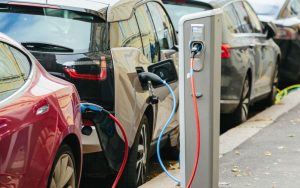Apple researching large-scale MagSafe technology for Apple Car charging

The Apple Car could have its own MagSafe-style charger alignment system, with contacts on a charging station automatically aligning perfectly with counterparts located on the electric car.
The often-rumored Apple Car has taken on many forms in speculation, but one repeated factor that crops up is its use of electricity to drive the vehicle. While it could take the form of a performance vehicle or a van, the suggestion it will be an electric vehicle has been quite prevalent.
If Apple were to create an electric car and offer it to the public in some form, it does have to counter the problem of recharging the vehicle. Unlike petrol and diesel vehicles that hold fuel and are left alone at night, electric vehicle users are used to the idea of recharging the car overnight, as the hours without use is a perfect opportunity for such activity.
The problem here is that users have to remember to recharge their vehicle when they park at night, something liquid fuel-based vehicle owners do not have to consider. For electric cars to be as accepted as petrol versions, it has to be as easy to use without too much thought.
This would, in theory, entail putting the electric car on charge without the user needing to do anything, or engineering the parking situation so that users park the vehicle in such a way to automatically engage recharging.
In a patent granted by the US Patent and Trademark Office on Tuesday titled “Charging station with passive alignment mechanism,” Apple suggests such an engineering system that could allow for drivers to park up and for the vehicle to start charging immediately.
The system largely involves a charging station with a charging plug designed to slot into a receiving socket on the vehicle itself. The plug is attached to sliding rods that can move the position of the plug around vertically and horizontally, to allow for imperfect parking attempts by the driver and for variances in the height of the vehicle.
While the height of the socket on the vehicle is likely to be the same across models and even manufacturers, there are still some potential ways for the height to vary. Two examples would be additional weight put into the vehicle as load, and the pressure of the tires.

In operation, the vehicle would have a cover for its charging socket that opens by moving upward, as it approaches a charging station. The driver, or self-driving vehicle system, has to attempt to position the vehicle as close to its intended end point as possible, to maximize the chance of a suitable connection with the charging station.
The parking job doesn’t have to be perfect, just within a range that allows the charging plug to make a connection. The rest of the patent explains the plug can refine its position to where it is needed, and can do so relatively passively.
The charging point’s movement by the sliding rods allow the plug to be pushed back by the vehicle, such as if the driver has moved the vehicle closer to the charging station, to minimize damage from the plug impacting the vehicle.

For added protection of the potentially fragile charging plug, a plate is located above the component, to handle any heavy impacts. It will also help to guide the plug in a downward slide to meet the socket by pressing against the vehicle’s flap, which is also angled to encourage movement towards the socket itself.
To further increase the chances of a suitable connection, the area surrounding the socket could also act as a funnel, diverting the plug into the receptacle. Apple also suggests the use of a magnet to secure the coupling.
Lastly, the charging plug itself will be able to pivot vertically and horizontally, altering the angle to ensure a perfect seating, once maneuvered into the right place.

The patent lists its inventors as Matthew M. Torok, Foster D. Collins, and William M. Price, and was filed on May 18, 2020.
Apple files numerous patent applications on a weekly basis, but while the existence of a patent filing indicates areas of interest for Apple’s research and development efforts, there’s no guarantee that Apple will use the ideas in a future product or service.
Recharging an electric car has cropped up a few times in Apple’s patents, especially in ways that do not require much in the way of driver assistance, aside from parking a car properly.
In July 2019, the “Wireless Charging Alignment System,” Apple suggests how a self-driving system could park the car in a position ideal for wireless charging, using a transmitter embedded in the parking space.
The same year, a “Charging System” was proposed that consisted of a small robotic device that could move along a floor under a vehicle, one that would raise a charging element close to a receiver on the car to perform wireless charging.
Such systems do not have to be tied to a stationary vehicle. In 2018, Apple thought about a “Peloton” of self-driving vehicles that are close enough together in a convoy that they can connect together. The peloton would reduce drag to save fuel, and could allow for vehicles to share energy reserves with each other, minimizing the need to stop and refuel.